Botany
The Roots
- The palm has adventitious roots continually produced from the base of the trunk, which is the swollen part or what is termed 'bole', in tall types and in some dwarf hybrids.
- It has no taproot or root hairs but has lots of primary roots which bear large quantities of rootlets.
- The main roots grow out somewhat horizontally from the bole and are mostly found within the topsoil. The main branches grow deeper and may extend laterally to as much as 10 m.
- The roots, having no cambium, are noticeably uniform - the main roots reaching a maximum diameter of about 1 cm. The root tip is the actively growing region and behind it is the absorbing area whose epidermis is a single layer of thin-walled cells that gradually thicken and become impervious with age.
- In old roots, the epidermis disintegrates and exposes the hard hypodermis which is generally red.
- The root centre has a stele surrounded by a single-celled pericycle sheath from which rootlets and aerenchymatous (respiratory exchange) protuberances or pneumatophores arise. The respiratory exchange occurs more abundantly nearer the soil surface to allow easy diffusion of root.
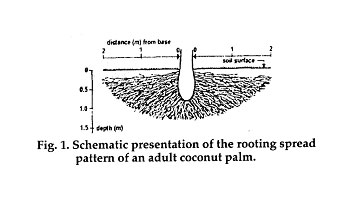 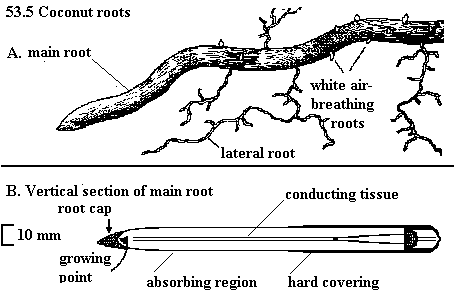
Coconut Root System
Stem
- The stem is called as trunk
- It is unbranched, erect, stout and cylindrical
- The leaf base encircles the stem as they have scars with pit mark on the trunk
- The scars are helpful in determining the age of the tree. Based on these 12 to 14 scars, the age can be computed for a year
- First few years there is increased growth in the thickness of the stem
- The girth remains uniform for a number of years and finally tapers in growth when the tree grows very old
- The trunk carries a big crown with large sized leaves and bunches of fruits
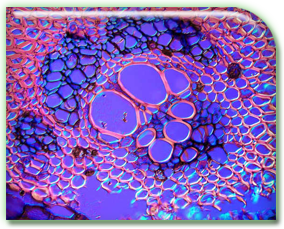
Transverse Section of Coconut Stem |
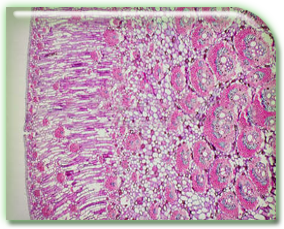
Light Micrograph of a Transverse Section of
Coconut Stem |
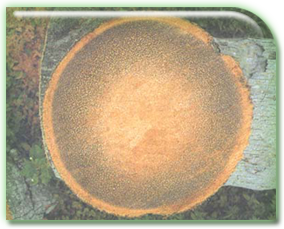
Cross Section of Coconut Stem at Breast Height |
| |
|
|
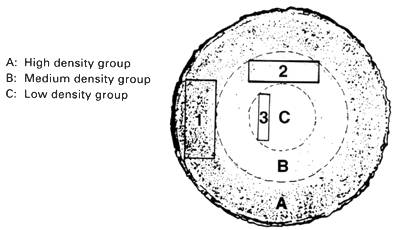 Cross Section of Coconut Stem with Cross Section of Coconut Stem with
Density Zones |
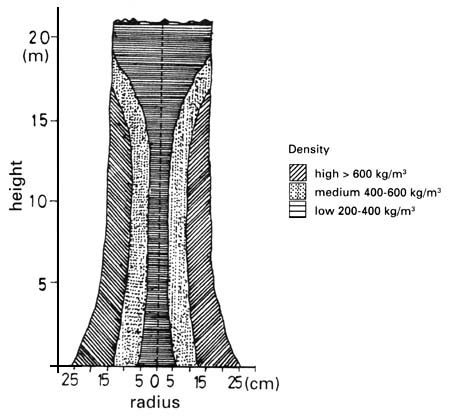 Schematic Density Distribution in Mature Coconut Stem Schematic Density Distribution in Mature Coconut Stem
|
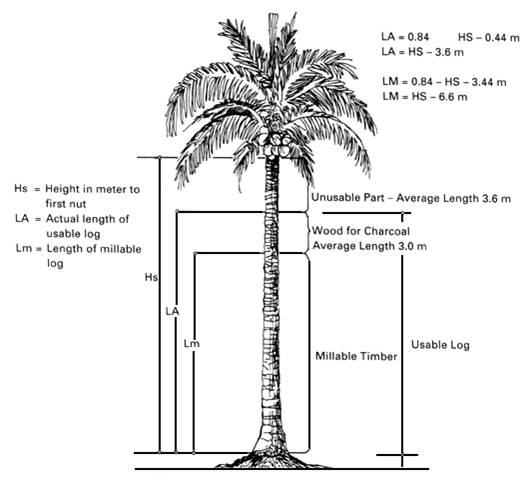 Use of the Coconut Stem Use of the Coconut Stem |
Leaf
- The leaves are crowded together at the top of the trunk in the form of a crown
- The young leaf appears in the centre of the crown as a pointed structure having all the leaves closely held together
- It takes five months for the complete development of a leaf from the time of initiation to its complete emergence
- The crown has 15 open leaves, 15 younger leaves in different stages of development
- The leaf consists of many leaflets arranged obliquely on the mid-rib or rachis
- Each leaflet is long, linear, has a strong mid-rib with narrow lamina and parallel venation
- The petiole is flat, very thick, broad and sheathe with fibre at the base and encircles the stem
|

Coconut Leaf |
Inflorescence
- It takes 34 months for the inflorescence to develop from the initiation to the opening of the spathe
- The spadix is stout and erect, enclosed by the tough spathe which splits when inflorescence is mature
- The axis of the inflorescence is branched, with the branches bearing sessile flowers, both staminate and pistillate
- The palm is monoceious with male and female flowers on the same plant
- Staminate flowers are small, numerous and are arranged closely on the secondary branches of the inflorescence
- They have six perianth lobes in two whorls and the outer perianth are small, the inner perianth is bigger
- Stamens are six and plenty of pollen is produced. An abortive psitillate or rudimentary ovary is present in the staminate flower. The pollen grains are spherical in shape and are smooth
- Pistillate flowers are at about the base of the branches substened by one or two staminate flowers
- They are small spherical structure known as ‘button’
- Six perianth lobes in two whorls arranged imbricate and more or less of the same size and shape
- The perianth is rounded, concave and whitish, the stigma is found at the base of the ovary
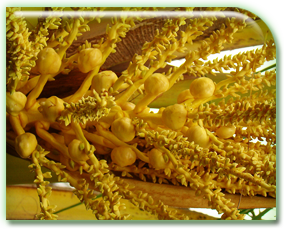
Coconut Inflorescence |
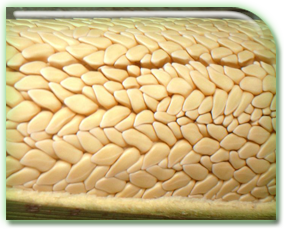
Coconut Flower Inside View |
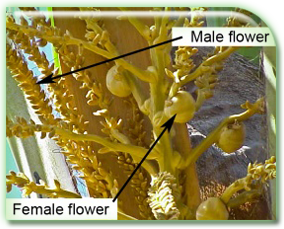
Male and Female Flower |

Coconut Flower - Close View |
Fruit
- Once pollination and fertilization occur, fruits set and develop to maturity in about 12 months, or less than 1 year for some dwarf cultivars. A count of bunch and fruit set can give a reasonable estimate of yield.
- Fruit is drupe, having three regions and one seeded .On the outside is the husk
- The fruit is developed from a tricarpellary ovary
- The outer layers of pericarp are fibrous called as husk which is initially green but turns brown after being picked and dried.
- The endocarp is very hard and forms the shell
- Within the endocarp, soft white endosperm enclosing inside a big cavity filled with extra-cellular fluid called as "coconut milk." The seed coat, which is thin, and then the white flesh or copra. Both the copra and the milk are the endosperm of this seed
- Initially the milk is fairly sweet and the copra is thin, but as the seed matures, the liquid is converted into solid endosperm rich in oils (triglycerides)
- The endosperm or the kernel also contains sucrose, fructose, galactose, glucose and raffinose
- The moisture content in the kernel diminishes as the maximum quantity of oil is formed when the nuts are 9-10 months old
- Liquid endosperm contains large quantities of cytokinin hormone which is useful to grow plants in test tubes from single cells and this develops into embryos

Immature Coconut Fruit |
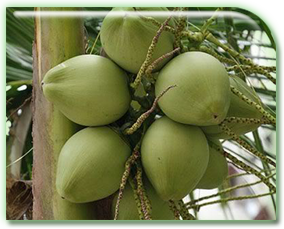
Young Coconut |
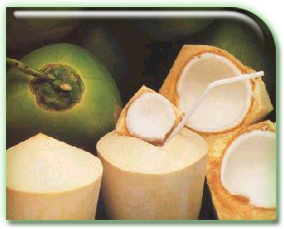
Tender Coconut |

Mature Coconut Fruit |
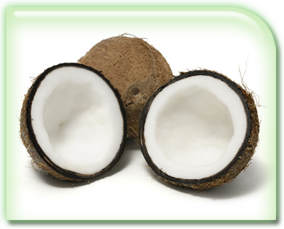
Raw Coconut Cross |

Section of a Coconut |
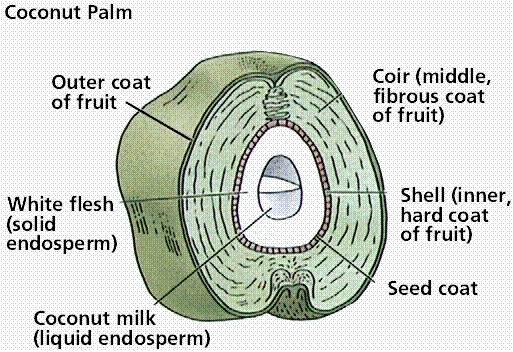
Coconut Endosperm |

Comparison of Early and Late Germination |
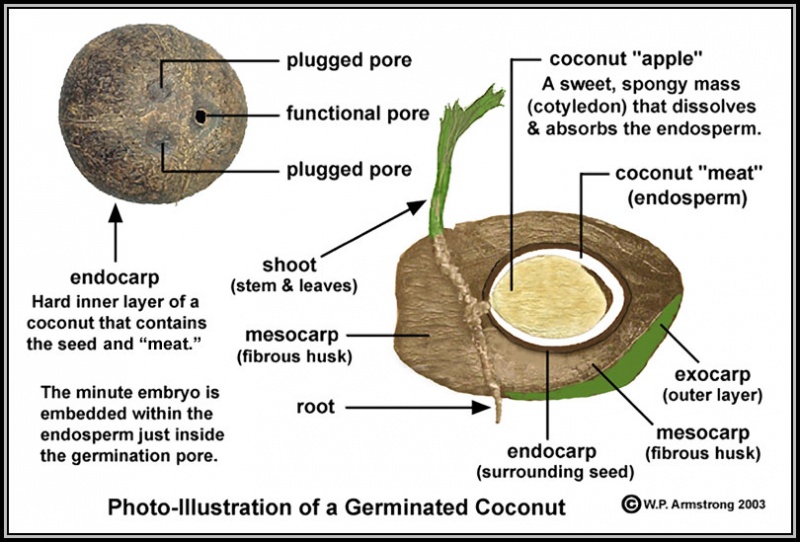
Photo Illustration of a Germinated Coconut |
|
|
|

